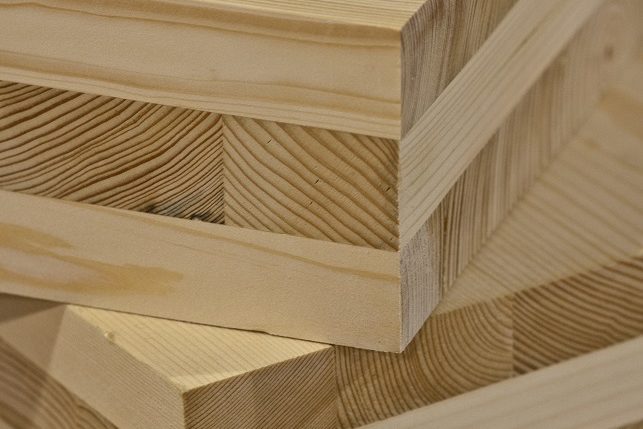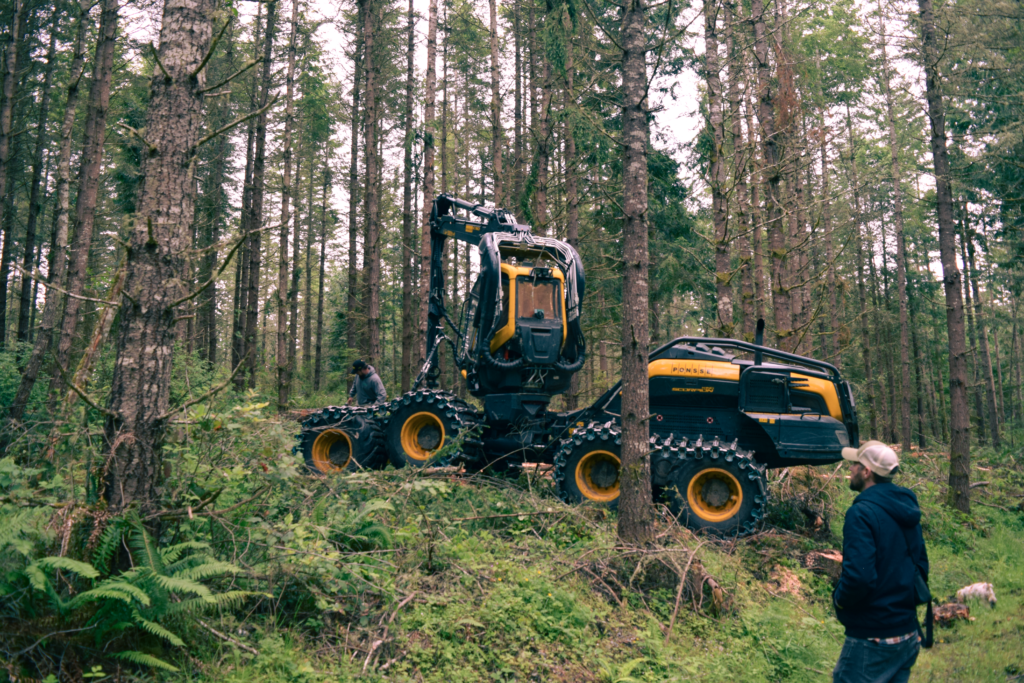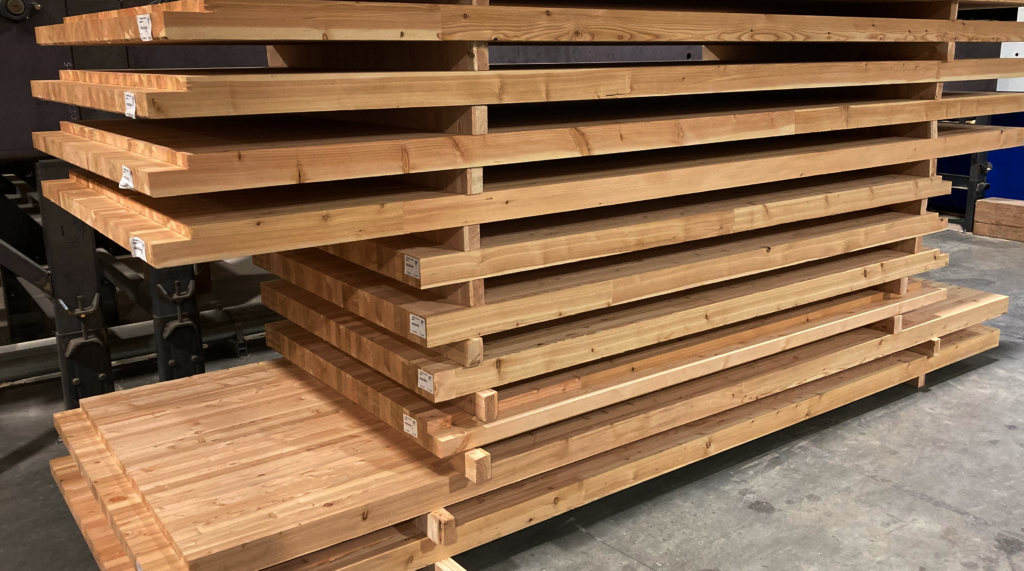Climate Smart Wood
Climate-smart wood is wood that comes from forests managed for social and ecological benefits that may include clean water, climate resilience, and carbon storage. Learn more about what makes some wood climate-smart, what the current challenges are for encouraging climate-friendly practices, and efforts in local and state policy to promote climate-smart practices in manufacturing wood products.

Week 1: An Introduction to Climate Smart Wood
You may have been hearing a lot about wood construction lately and how wood can be a carbon-friendly building material. The reality is a bit more complicated. The Buy Clean, Buy Fair bill under consideration by the legislature this session is one initiative to provide transparency about wood building materials, allowing buyers to make more informed procurement decisions. Buy Clean, Buy Fair provides information on manufacturing labor standards, carbon footprint, and origin of building materials used in state-funded construction. As this bill is considered in the legislature over the next few weeks, we’ll be sharing with you some of the nuances around when and how “wood can be good.”
“Climate-smart wood” is wood harvested from forests managed both for carbon sequestration and storage as well as other ecological and socioeconomic benefits (habitat, stream temperatures, wildfire mitigation, forest products, etc.). It’s important to keep in mind that climate-smart wood isn’t only about carbon. Trees are part of complex ecosystems, and climate change brings many different impacts to those forest ecosystems. We need management that reflects this complexity for wood products to be truly climate-smart.
We can produce climate-smart wood through ecological forestry, which is a set of forest management practices that support ecosystem health. The unique characteristics of each forest – including geography, species composition, precipitation levels, and more – determine which ecological management strategies make sense to implement. Some of the major strategies used for ecological forestry are:
1. Longer rotations, which allow trees to capture more carbon, create more shade and cooler temperatures for streams (older trees take in less water, meaning more volume for streams!), and provide critical habitat for threatened and endangered wildlife;
2. Controlled burning, which returns nutrients to soil while reducing the risk of catastrophic wildfire and is important for lifecycles of forest flora;
3. Restoration thinning, which helps restore forest health and create complex habitat — and together with controlled burning can reduce wildfire risk and promote climate-resilient ecosystems.

Week 2: Climate-Smart Wood and Washington’s Rural Economies
Climate-smart wood production can generate local employment in both forestry and manufacturing. Many climate-smart forestry practices require more frequent, smaller-scale management actions, e.g., ecological restoration, creation of ‘uneven-aged’ stands with trees of different ages, periodic thinning, and prescribed burns.
In contrast, conventional, intensive forest management practices remove all or most trees in a single harvest — known as clearcutting. For this reason, climate-smart forest management requires more employment to produce a given volume of wood. Production of climate-smart wood products like cross-laminated timber is also an opportunity to generate local employment in mills and manufacturing facilities. Builders and developers are increasingly seeking to procure climate-smart wood products, which creates an opportunity for Washington to position itself as a leader in the climate-smart wood economy.
“Builders and developers are increasingly seeking to procure climate-smart wood products, which creates an opportunity for Washington to position itself as a leader in the climate-smart wood economy.”
Climate-smart forestry can bring economic growth and advance a just transition, but requires a skilled workforce to carry out ecological management practices. Workforce development efforts are needed to generate this skilled forestry workforce. Last year, both the Climate Commitment Act and a wildfire funding bill (HB 1168) committed to funding to develop a forest health workforce. These workforce development efforts prioritize marginalized, underrepresented, rural, and low-income communities, as well as providing job training for formerly incarcerated people who are on the front lines of fighting wildfire on state fire response crews. WEC is following how funds allocated through HB 1168 are spent, and will continue to advocate for funding to support sustainable jobs for Washington’s rural and overburdened communities.
One example of a Washington business enabling climate-smart wood supply chains is Vaagen Timbers, located in Colville. Since 2018, Vaagen has produced mass timber products using smaller diameter wood sourced from restoration efforts. Vaagen participates in the Northeast Washington Forest Coalition alongside a range of stakeholders including local Tribes, industry, conservation groups, and government agencies. This forest collaborative works toward collective decision-making and provides input on management plans in the Colville National Forest towards the goal of forest health and thriving local communities.
A Washington Buy Clean, Buy Fair policy can support local climate-smart wood economies by providing transparency over carbon impacts and forest certification status of wood products, as well as labor standards in manufacturing facilities. This information allows buyers of wood to identify and procure climate-smart wood. Next week, we will focus on the bill itself and how it supports both environmental and labor priorities.

Week 3: Climate-Smart Wood Procurement in Local & State Policy
As interest in decarbonizing the building sector and use of low-carbon materials grows, state governments, local governments, and private sector builders and developers increasingly want to use climate-smart wood in their projects. Such demand for climate-smart wood helps generate greater transparency over wood sourcing and the carbon impacts of wood, and also supports local, ecologically and socially responsible sourcing.
At a local level, cities and counties in Washington can incorporate sourcing of climate-smart wood into city and county procurement policies. Procurement policies outline what types of materials are used in new building construction or renovation – in this case, public building projects. Procurement policies can be a strategic component of a larger Climate Action Plan, or as a standalone effort. King County’s 2020 Strategic Climate Action Plan and the City of Seattle’s Priority Green Building Expedited permitting process include strategies to support prioritization of climate-smart building materials. The City of Portland’s Sustainable Procurement Policy addresses climate-smart materials for city projects, and offers a model that can be applied in Washington’s cities and counties as well.
At the state level, passage of Buy Clean, Buy Fair legislation would pave the way for greater transparency and sourcing information to guide climate-smart wood procurement for state construction projects and beyond. While efforts to pass Buy Clean, Buy Fair have not yet been successful, a 2021 budget proviso directed development of an online database to collect data on certain wood, steel, and concrete building materials, as well as case studies that analyze implementation of climate-smart practices in publicly funded construction projects in Washington. The database will gather information about the carbon footprint of building materials and labor conditions at manufacturing facilities. For wood, the database will also capture the state/province of origin, land ownership type, and forest management certification, providing greater insight into forest-level impacts. The database will provide valuable information to guide procurement for public or private construction projects and can inform future Buy Clean, Buy Fair efforts.
Existing state and regional efforts support a focus on reducing embodied carbon of building materials in Washington. For example, Washington’s 2021 State Energy Strategy calls for use of building materials with low embodied carbon emissions. At COP26 in November, the new Low Carbon Construction Task Force of the Pacific Coast Collaborative was announced, which includes Washington, California, Oregon, and British Columbia. These new initiatives provide a framework and collaboration to advance climate-smart building.
In addition to government leadership, architecture, engineering, and construction industry interest in low-carbon building is driving complementary demand for climate-smart building materials, as well as greater traceability and transparency into impacts. Paired with local and state policy efforts, this momentum can help drive construction materials for all types of buildings toward a more climate-smart future.
Your donation ensures a sustainable future.
